German diaspora
German diaspora (German: Deutschstämmige; also, under National Socialism: Volksdeutsche) are ethnic Germans and their descendants living outside Germany. It also refers to the aspects of migration of German speakers from central Europe to different countries around the world. This definition describes the "German" term as a sociolinguistic group as opposed to the national one since the emigrant groups came from different regions with diverse cultural practices and different varieties of German. For instance, the Alsatians and Hessians were simply called Germans once they set foot in their new homelands.
Part of a series on the |
||||||||||
|---|---|---|---|---|---|---|---|---|---|---|
| History of Germany | ||||||||||
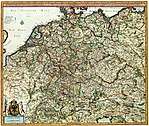 | ||||||||||
| Topics | ||||||||||
| Early history | ||||||||||
| Middle Ages | ||||||||||
| Early Modern period | ||||||||||
| Unification | ||||||||||
|
||||||||||
| German Reich | ||||||||||
|
||||||||||
| Contemporary Germany | ||||||||||
|
||||||||||
|
| ||||||||||
Terminology
Volksdeutsche ("ethnic Germans") is a historical term which arose in the early 20th century and was used by the Nazis to describe ethnic Germans without German citizenship living outside of the Third Reich, although many had been in other areas for centuries. During World War II, Hitler forbade the use of the term because it was being used in a derogatory way against the many ethnic Germans in the SS. It is used by many historians who either deliberately or innocently are unaware of its Nazi history.
Auslandsdeutsche (adj. auslandsdeutsch) is a concept that connotes German citizens, regardless of which ethnicity, living abroad, or alternatively ethnic Germans entering Germany from abroad. Today, this means a citizen of Germany living more or less permanently in another country (including expatriates such as long-term academic exchange lecturers and the like), who are allowed to vote in the Republic's elections, but who usually do not pay taxes to Germany but in their resident states. In a looser but still valid sense, and in general discourse, the word is frequently used in lieu of the ideologically tainted term Volksdeutsche, denoting persons living abroad without German citizenship but defining themselves as Germans (culturally or ethnically speaking).
Distribution
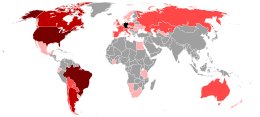
Ethnic Germans are a minority group in many countries. (See Germans, German language, and German as a minority language for more extensive numbers and a better sense of where Germans maintain German culture and have official recognition.) The following sections briefly detail the historical and present distribution of ethnic Germans by region, but generally exclude modern expatriates, who have a presence in the United States, Scandinavia and major urban areas worldwide. See Groups at bottom for a list of all ethnic German groups, or continue for a summary by region.
In the United States census of 1990, 57 million people were fully or partly of German ancestry, forming the largest single ethnic group in the country as well as the largest population of Germans outside of Germany. According to the United States Ancestry Census of 2009, there were 50,764,352 people of German descent in the U.S.[1] People of German ancestry form an important minority group in several countries, including Canada (roughly 10% of the population), Argentina (roughly 8% of the population),[2] Brazil (roughly 3% of the population),[3] Australia (roughly 4.5% of the population),[4] Chile (roughly 3% of the population),[5] Namibia, and in central and eastern Europe—(Poland, Hungary, Romania, and Russia).
Distribution of German citizens and people claiming German ancestry (figures are only estimates and actual population could be higher, because of wrongly formulated questions in censuses in various countries (for example in Poland)[6] and other different factors, f.e. related to participant in a census):
| Country | German ancestry | German citizens | Comments |
|---|---|---|---|
| 46,882,727 (2012) (almost all German Americans come from Germany)[7][note 1] | see German American; the largest German population outside Germany. | ||
| 12,000,000 (2000)[8] | see German Brazilian; the second largest German population outside Germany. | ||
| 3,500,000 (majority come from Russia and Germany)[9][10][11] | 50,000[10] | see German Argentine. | |
| 3,203,330 (2011) (majority come from Germany)[12] | see German Canadian. | ||
| 2,000,000 (2016) (majority come from Germany)[13] | see German Mexicans | ||
| 1,200,000 (2009)[14][15][note 2] | see Afrikaners. | ||
| 1,000,000 (2010)[16][17][note 3] | 204,000[18][19][20] | see Alsace and Lorraine. | |
| 898,700 (2011) (majority come from Germany)[4][21] | see German Australian. | ||
| 500,000[22] | 8,515 | see German Chilean. | |
| 394,138 (2010) (majority come from Prussia) | see Germans in Russia, Volga Germans, Caucasus Germans, Black Sea Germans and Crimea Germans. | ||
| 375,000 (2014)[23] | see Ethnic Germans in Bolivia. | ||
| 372,720 (2013)[24][25] | 179,000[25] | ||
| 314,604 (2011)[26][note 4] | see German-Italian relations | ||
| 273,654 (2011)[27][note 5] | 92,000[28] | see German migration to the United Kingdom. | |
| 290,000 (2000) (majority come from Brazil)[29] | |||
| see note[note 6] | 266,000[30] | see German immigration to Switzerland and Swiss people. | |
| 240,000 [31] | see German Peruvian | ||
| 178,409 (2009)[32] |
see Germans in Kazakhstan. | ||
| 138,917 (2014)[33] | see Germany-Spain relations | ||
| 148,000 (2011)[34] | see German minority in Poland. | ||
| 131,951 (2011)[35] | see Germans of Hungary. | ||
| see note[note 7] | 170,475[36] | see Austrians. | |
| 100,000[37] | see Sarona (colony), German Colony, Haifa and German Colony, Jerusalem | ||
| 73,000 (2008)[note 8] | see German-speaking Community of Belgium. | ||
| 36,884 (2011)[38] | see Germans of Romania, Transylvanian Saxons, Zipser Germans. | ||
| 40,000 (2014)[39] | 6,000[40] | ||
| 18,772 (2011)[41] | see Germans in the Czech Republic. | ||
| 25,000 (2012)[42] | see Germany-Norway relations | ||
| 33,302 (2001) | see Black Sea Germans and Crimea Germans. | ||
| 30,000 (2013)[43] | see German Namibian. | ||
| 25,000[44] | 1,792 (2012)[45] | ||
| 15,000[46][47] | see North Schleswig Germans. | ||
| 15,498[48] | see Greece-Germany relations. | ||
| 12,387 | see German Cuban | ||
| 10,000 (2006)[49] | 11,305[50] | ||
| 10,865 (2010)[51] | see Mennonites in Belize. | ||
| 5,000–10,000[52] | see Carpathian Germans, Zipser Germans | ||
| 8,563 (2014) | see Germans in Kyrgyzstan. | ||
| 6,400[53] | see German settlement in the Philippines. | ||
| 4,064 (2011) | 850 (2016) [54] | see Germans of Serbia. | |
| 2,965 (2011)[55] | see Germans of Croatia. | ||
| 1,544 (2011) | |||
| see note[note 9] | see Liechtensteiners. | ||
| see note[note 10] | see Luxembourgers. | ||
| 4,975 (2014) | |||
| 2,418 (2011) | |||
| 8,894 (2019)[56] | 4,102 (2018)[57] | Germans in Finland | |
| 842 (2013) | |||
| 10,030 (2016)[58] | |||
| 115,550 (2013)[59] | 29,213 (2018)[60] | see Germany–Sweden relations | |
| 12,810 (2013) | see German New Zealander. | ||
| Unknown number of individuals of German descent | |||
| see German Venezuelan. | |||
| Unknown number of individuals of German descent[61] | 7,000-10,000 (2010)[62] | see German Guatemalan | |
| Unknown number of individuals of German descent | see German Nicaraguan. | ||
| Unknown number of individuals of German descent | 9,668 (2011)[63] | see German Colombian. | |
| Unknown number of individuals of German descent | see Germans in Jamaica. | ||
Europe
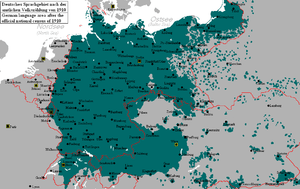
Alpine nations
Austria, Switzerland, and Liechtenstein each have a German-speaking majority, though the vast majority of the population do not identify themselves as German anymore. Austrians historically were identified and considered themselves Germans until after the defeat of the Third Reich and the end of World War II. Post-1945 a broader Austrian national identity began to emerge, and over 90% of the Austrians now see themselves as an independent nation.[64][65][66]
East-Central Europe
Aside from the Germans who migrated to other parts of Europe, the German diaspora also covered the Eastern and Central European states such as Croatia, Hungary, Poland, the Czech Republic, and Slovakia, along with several post-Soviet states. There has been a continued historical presence of Germans in these regions due to the interrelated processes of conquest and colonization as well as migration and border changes.[67] During the periods of colonization, for instance, there was an influx of Germans who came to Bohemia and parts of Romania as colonizers. Settlements due to border changes were largely 20th century developments caused by the new political order after the two world wars.[67]
Baltic states
Belgium
In Belgium, there is an ethnic German minority. It is the majority in its region of 71,000 inhabitants. Ethnologue puts the national total of German speakers at 150,000, not including Limburgish and Luxembourgish.
Luxembourg
Though the Luxembourgish language is closely related to the German language, Luxembourgers do not consider themselves ethnic Germans. In a 1941 referendum held in Luxembourg by ethnic German residents, more than 90% proclaimed themselves Luxembourgish by nationality, mother tongue and ethnicity.[68]
Bulgaria
Czech Republic and Slovakia
Before World War II, some 30% of the population in Czech Republic (historically known as Bohemia and Moravia) were ethnic Germans, and in the border regions and certain other areas they were in the majority.[69] There are about 40,000 Germans in the Czech Republic (number of Czechs who have at least partly German ancestry probably runs into the hundreds of thousands).[70] Their number has been consistently decreasing since World War II. According to the 2001 census there remain 13 municipalities and settlements in Czech Republic with more than 10% Germans.
The situation in Slovakia was different from that in Czech Republic, in that the number of Germans was considerably lower and that the Germans from Slovakia were almost completely evacuated to German states as the Soviet army was moving west through Slovakia, and only a fraction of those who returned to Slovakia after the end of the war were deported with the Germans from the Czech lands.
Many representatives of expellee organizations support the erection of bilingual signs in all formerly German-speaking territory as a visible sign of the bilingual linguistic and cultural heritage of the region. The erection of bilingual signs is permitted if a minority constitutes 10% of the population.
Denmark
In Denmark, the part of Schleswig that is now South Jutland County (or Northern Schleswig) is inhabited by about 12,000–20,000 ethnic Germans [71] They speak mainly Standard German and South Jutlandic. A few speak Schleswigsch, a Northern Low Saxon dialect.
Hungary
Prior to World War II, approximately 1.5 million Danube Swabians lived in Hungary, Romania and Yugoslavia.[72] Today the German minority in Hungary have minority rights, organisations, schools and local councils, but spontaneous assimilation is well under way. Many of the deportees visited their old homes after the fall of the Iron Curtain in 1990.
Italy
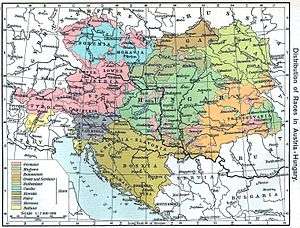
There are smaller, unique populations of Germans who arrived so long ago that their dialect retains many archaic features heard nowhere else: the Cimbrians are concentrated in various communities in the Carnic Alps, north of Verona, and especially in the Sugana Valley on the high plateau northwest of Vicenza in the Veneto region; the Walsers, who originated in the Swiss Wallis, live in the provinces of Aostatal, Vercelli, and Verbano-Cusio-Ossola; the Mòchenos live in the Fersina Valley. Smaller German-speaking communities also exist in the Friuli Venezia Giulia region: the Carinthians in the Canale Valley (municipalities of Tarvisio, Malborghetto Valbruna and Pontebba) and the Zahren and Timau Germans in Carnia.
Contrarily to the before-mentioned minorities, the German-speaking population of the province of South Tyrol cannot be categorized as "ethnic German" according to the definition of this article, but as Austrian minority. However, as Austrian saw themselves as ethnic Germans until the end of World War II they can technically also be called Germans.[73] The province was part of the Austrian County of Tyrol before the 1919 dissolution of the Austro-Hungarian Empire. South Tyrolians were part of the over 3 million German speaking Austrians who in 1918 found themselves living outside of the newborn Austrian Republic as minorities in the newly formed or enlarged respective states of Czechoslovakia, Yugoslavia, Hungary and Italy. Their dialect is Austro-Bavarian German. Both standard German and dialect are used in schooling and media. German enjoys co-official status with the national language of Italian throughout this region.
Germans have been present in the Iglesiente mining region in the south west of Sardinia since the 13th century.[74] Successively since 1850 groups of specialised workers from Styria, Austria, followed by German miners from Freiburg settled in the same area. Some Germans influenced building and toponym is still visible in this area.[75][76]
Norway
In Norway, there are 27,770 Germans making Germans the ninth largest ethnic minority in the country, making up 0.52% of Norway's total population, and 2.94% of all foreign residents in Norway.[77] Imigration from Germany to Norway has been going on since the Middle Ages. There was many Germans that migrated to Bergen during the Middel Ages and during Norway`s union with Denmark. During the Union with Denmark a lot of German miners migrated to the town of Kongsberg.[78] As of 2020 there is 1,446 Germans in the city of Bergen making up 0.51% of the total population, and in the town of Kongsberg there are 114 Germans making up 0.41% of the total population. The city with the biggest population of Germans is Oslo. 3,743 Germans lives in the city making up 0.55% of the total population.[79]
Germany is also the country that sends the most foreign exchange students to Norway, in 2016, 1,570 exchange students came to Norway from Germany.[80]
Poland

The remaining German minority in Poland (109,000 people were registered in the 2011 census[81]) enjoys minority rights according to Polish minority law. There are German speakers throughout Poland, and most of the Germans live in the Opole Voivodship in Silesia. Bilingual signs are posted in some towns of the region. In addition, there are bilingual schools and German can be used instead of Polish in dealings with officials in several towns.
Romania
Since the High Middle Ages, the territory of present-day Romania has been continuously inhabited by German-speaking groups, firstly by Transylvanian Saxons then, gradually, by other immigrant groups of ethnic German origin. They are all politically represented by the Democratic Forum of Germans in Romania.
France
In France over 100,000 German nationals residing in the French country (the exact number is not known, some statistics indicate more than 300,000 Germans in France but are not officially sanctioned.) There, the Germans live mainly in the northeastern area of France, i.e., in regions close to the Franco-German border (i.e. Alsace), and the sunny island of Corsica, similarly like many German tourists in the coastal resorts of Spain.
German tourists are the most frequent visitors of France (more than British tourists in France) in the year 2013.
United Kingdom
In the United Kingdom, a German-Briton ethnic group of around 300,000 exists. Some are descended from nineteenth-century immigrants. Others are 20th-century immigrants and their descendants: (Ethnic Jews who fled Nazi Germany in the 1930s are not ethnic Germans), and World War II prisoners of war held in Great Britain who decided to stay there. Others arrived as spouses of English soldiers from post-war marriages in Germany, when the British were occupying forces. Many of the more recent immigrants have settled in the London and southeast part of England, in particular, Richmond (South West London).
The British Royal Family are partially descended from German monarchs.
The Anglo-Saxon tribe were the population in Britain descended from the Germanic tribes who migrated from continental Europe and settled the south and east of the island beginning in the early 5th century. The Anglo-Saxon period denotes the period of English history after their initial settlement through their creation of the English nation, up to the Norman conquest; that is, between about 550 and 1066.[1][2] The term Anglo-Saxon is also used for the language, today more correctly called Old English, that was spoken and written by the Anglo-Saxons in England (and parts of south-eastern Scotland) between at least the mid-5th century and the mid-12th century, after which it is known as Middle English.[3]
Africa

During the long decline of the Roman Empire and the ensuing great migrations Germanic tribes such as the Vandals (who sacked Rome) migrated into North Africa and settled mainly in the lands corresponding to modern Tunisia and northeastern Algeria. While it is likely that some of the people living there at present are descended from these Germanic peoples, they did not leave visible cultural traces.
Cameroon
The first German trading post in the Duala area on the Kamerun River delta was established in 1868 by the Hamburg trading company C. Woermann. The firm's agent in Gabon, Johannes Thormählen, expanded activities to the Kamerun River delta. In 1874, together with the Woermann agent in Liberia, Wilhelm Jantzen, the two merchants founded their own company, Jantzen & Thormählen there. At the outbreak of World War I, French, Belgian and British troops invaded the German colony in 1914 and fully occupied it during the Kamerun campaign. The last German fort to surrender was the one at Mora in the north of the colony in 1916. Following Germany's defeat, the Treaty of Versailles divided the territory into two League of Nations mandates (Class B) under the administration of Great Britain and France. French Cameroun and part of British Cameroons reunified in 1961 as Cameroon, though some Germans still remain in Cameroon.
Namibia
Germany was not as involved in colonizing Africa as other major European powers of the 20th century, and lost its overseas colonies, including German East Africa and German South West Africa, after World War I. Similarly to those in Latin America, the Germans in Africa tended to isolate themselves and were more self-sufficient than other Europeans. In Namibia there are 30,000 ethnic Germans, though it is estimated that only a third of those retain the language. Most German-speakers live in the capital, Windhoek, and in smaller towns such as Swakopmund and Lüderitz, where German architecture is highly visible.
South Africa
In South Africa, a number of Afrikaners and Boers are of partial German ancestry, being the descendants of German immigrants who intermarried with Dutch settlers and adopted Afrikaans as their mother tongue. Professor JA Heese in his book Die Herkoms van die Afrikaner (The Origins of Afrikaners) claims the modern Afrikaners (who total around 3.5 million) have 34.4% German ancestry.[82]
Germans also emigrated to South Africa during the 1850s and 1860s, and settled in the Eastern Cape area around Stutterheim, and in Kwazulu-Natal in the Wartburg area, where there is still a large German-speaking community.[83] Mostly originating from different waves of immigration during the 19th and 20th centuries, an estimated 12,000 people speak German or a German variety as a first language in South Africa.[84] Germans settled quite extensively in South Africa, with many Calvinists immigrating from Northern Europe. Later on, more Germans settled in the KwaZulu-Natal and elsewhere. Here, one of the largest communities are the speakers of "Nataler Deutsch", a variety of Low German, who are concentrated in and around Wartburg. German is slowly disappearing elsewhere, but a number of communities still have a large number of speakers and some even have German language schools.
Tanzania
The country was organised when the German military was asked to put down a revolt. There are a small community of Germans remaining in Tanzania. Tanzania was sold to the British after the German colonization as well as Rwanda and Burundi being sold to the Belgians.
North America
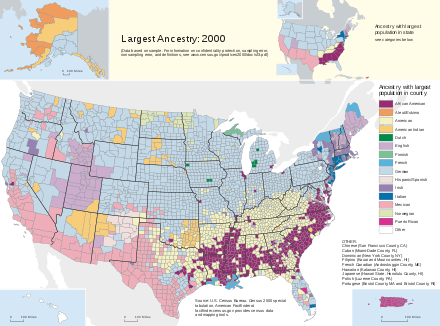

- Belize: 5,763 Mennonite Low-German speakers.
- Canada (3.2 million, 10% of the population), see also German Canadians.
- Mexico: See German immigration to Mexico, 100,000 Mennonites;[85] 22% of Mennonites also speaks Low German which is not Standard German but derived from Old Saxon, 30% speaks Spanish, 5% speaks English and 5% speaks Russian as second language.[86] Different sources estimates that there are between 15 000 and 40 000 German citizens and Mexicans of German-citizen origin.[87] Also of note, the 'Colegio Alemán Alexander von Humboldt', or Alexander von Humboldt school in Mexico City is the largest German school outside Germany.
- In the United States, German Americans are the largest ethnic group. There are around 50 million Americans of at least partial German ancestry in the United States, or 17% of the U.S. population, the country's largest self-reported ancestral group.[88] including various groups such as the Pennsylvania Dutch. Of these, 23 million are of German ancestry alone ("single ancestry"), and another 27 million are of partial German ancestry, making them the largest group in the United States, followed by the Irish. Of those who claim partial ancestry, 22 million identify their primary ancestry ("first ancestry") as German. The 22 million Americans of primarily German ancestry are by far the largest part of the German diaspora, a figure equal to over a quarter of the population of Germany itself. Germans form just under half the population in the Upper Midwest.[89][90]
- Central America: In 1940, there were 16,000 Germans living in Central America; half of them in Guatemala, and most of the remainder were established in Costa Rica.[91]
South America


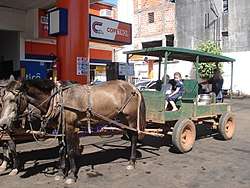
- Argentina: Those of German ancestry constitute about 8% of the Argentine population — over 3 million — most of them Volga Germans alone — about 2 million.[2] There are more than 400,000 of other German ancestries including Mennonites and German Swiss. These two groups are more common in Southern Argentina, and also in Santa Fe, Entre Rios and Cordoba provinces. A notable example is the town of Villa General Belgrano, founded by Germans in the 1930s. In the 1960s it became the site of the Fiesta Nacional de la Cerveza, or Oktoberfest, which has become a major attraction in Argentina.[92] By 1940, there were 250,000 people of German descent living in the country.[91] The German embassy in Argentina estimates that 660,000 Argentines, or 1.5% of the total population, are descendants of Germans who emigrated directly from Germany (It means that it doesn't includes other ethnic Germans who emigrated from Austria, Switzerland, Russia/USSR, etc.).[93][94] 50,000 German citizens live in Argentina.[10]
- Nazi Minister Walther Darré was born in Argentina. After the Second World War, almost a thousand prominent Nazi leaders and politicians fled to Argentina. Adolf Eichmann and Josef Mengele were among them. Kurt Tank, who developed some of the greatest World War II aircraft fighters, also entered Argentina in the late 1940s.[95]
- There are about 500,000 German-speakers in Argentina,[96] slightly over 1% of population.
- Bolivia: There are 2 different German groups, the descendants of those who emigrated from Germany and Brazil (estimated in about a quarter of million, 2.0% of Bolivian population[97]), and the descendants of Mennonites that emigrated from Canada and Mexico (at least 85,000 of them live in agrarian communities).[98][99] Germans are 375,000 or 3% of Bolivian population.[23]
- There are over 20,000 Standard German-speakers,[97] plus 85,000 Mennonite Low German-speakers.[98]
- Brazil: Mostly living in Southern Brazil. Brazil received 250,000 Germans between the 19th and 20th centuries; a source claimed there were 12 million people of German descent in 2000, 7% of the national population, but there are no official figures.[100] Hunsrückisch and East Pomeranian are some of the most prominent groups.[100][101][102]
By 1940, the German diaspora in Brazil amounted about a million.[91]
- There are 3 million German-speakers in Brazil,[96] slightly over 1.5% of population.
- Chile: The German-Chilean Chamber of Commerce estimated at 500,000 the descendants of Germans, about 3% of the total population of Chile estimated at 16 million (in the same source).[103] There are 40,000 Standard German-speakers.[104]
- Paraguay : 166,000 Standard German-speakers (including 18,000 Mennonites, who don't speak Plattdeutsch or Mennonite Low German), most Germans in Paraguay are of Brazilian descent and Portuguese speakers;[97] plus 20,000 Mennonite Low German, spoken by Mennonites who live in Chaco and Eastern Paraguay[97] The Mennonites emigrated to Paraguay from Chihuahua State (in Mexico), the Soviet Union, Canada, and Bolivia.[105][106] Non-Mennonites German emigrated to Paraguay mainly from Brazil, the Kingdom of Prussia, and the German Empire.[106]
- Those of German ancestry are 290,000 or 4.4% of Paraguayan population.[29]
- Peru: The communities of Oxapampa, Pozuzo, and Villa Rica in the high jungles of the Peruvian Amazon basin were settled in the middle of the 19th century by Austrian and Prussian immigrants. Many of its present-day inhabitants speak German[107] In the 18th century, German immigrants settled the areas of Tingo Maria, Tarapoto, Moyobamba, and the Amazonas Department.[108] German immigrants largely settled in Lima, and to a lesser extent Arequipa.[109] Over 160,000 Peruvians are German-descendants.[110]
- Uruguay: By 1940, there were 10,000 Germans living in the country.[91]
- Venezuela:
Asia
In Japan, during the Meiji period (1868–1912), many Germans came to work in Japan as advisors to the new government. Despite Japan’s isolationism and geographic distance, there have been a few Germans in Japan, since Germany's and Japan's fairly parallel modernization made Germans ideal O-yatoi gaikokujin. (See also Germany–Japan relations)
In China, the German trading colony of Jiaozhou Bay in what is now Qingdao existed until 1914, and did not leave much more than breweries, including Tsingtao Brewery.
Smaller numbers of ethnic Germans settled in the former Southeast Asian territories of Malaysia (British), Indonesia (Dutch) and the Philippines (American) in the late 19th and early 20th centuries. In Indonesia, some of them became well-known figures in history, such as C.G.C. Reinwardt (founder and first director of Bogor Botanical Garden), Walter Spies (German of Russian origin, who became the artist that made Bali known to the world), and Franz Wilhelm Junghuhn (owner of a big plantation in the south of Bandung and dubbed "the Humboldt of the East" because of his ethno-geographical notes).
Members of the German religious group known as Templers settled in Palestine in the late 19th century and lived there for several generations, but were expelled by the British from Mandatory Palestine during World War II, due to pro-Nazi sympathies expressed by many of them.
Communist East Germany had relations with Vietnam and Uganda in Africa, but in these cases population movement went mostly to, not from, Germany. After the German reunification, a large percentage of "guest workers" from Communist nations sent to East Germany returned to their home countries.
See also: German colonial empire and List of former German colonies
Oceania
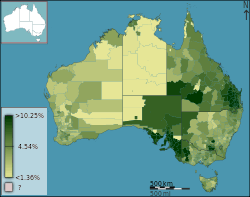
- Australia has received a significant number of ethnic-German immigrants from Germany and elsewhere. Numbers vary depending on who is counted, but moderate criteria give an estimate of 750,000 (4% of the population). The first wave of German immigration to Australia began in 1838, with the arrival of Prussian Lutheran settlers in South Australia (see German settlement in Australia). After the Second World War, Australia received a large influx of displaced ethnic Germans. In the 1950s and 1960s, German immigration continued as part of a large post-war wave of European immigration to Australia.
There have been ethnic Germans in Australia since the founding of the New South Wales colony in 1788, Governor Arthur Phillip (the first Governor of New South Wales) had a German father. But, the first significant wave of German immigration was in 1838. These Germans, mostly Prussian immigrants (but also winegrowers from the Hesse-Nassau state and the Rheingau). From there after, thousands of Germans emigrated to Australia until World War I. Also, German Australian was the most identified ethnicity behind English and Irish in Australia until World War I.
After World War II, large numbers of Germans emigrated to Australia to escape war-torn Europe.
- New Zealand has received modest, but steady, ethnic German immigration from the mid-19th century. Today the number of New Zealanders with German ancestry is estimated to be approximately 200,000 (5% of the population). Many German New Zealanders anglicized their names during the 20th century due to the negative perception of Germans fostered by World War I and World War II. New Zealanders of German descent include the late former Prime Minister David Lange. The vast majority of Germans in New Zealand settled in the North Island, with a couple settling in the Christchurch area. Cities such as Tauranga, Nelson and, to a lesser extent, Auckland have been somewhat influenced by German culture and values.
History
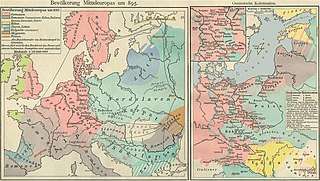
From Celtic times the early Germanic tribes settled from the Baltic all the way to the Black Sea until the great migrations of the 4-6th century AD.
Medieval Germans migrated eastwards during the medieval period Ostsiedlung until the flight, evacuation and expulsion of Germans after World War II; many areas in Central and Eastern Europe had an ethnic German population.[111][112] In the Middle Age, Germans were invited to migrate to Poland and the central and eastern regions of the German Holy Roman Empire and also the Kingdom of Hungary following the Mongol invasions of the 12th century, and then once again during the late 17th century after the Austrian-Ottoman wars to set up farms and repopulate the eastern regions of the Austrian Empire and Balkans.
The Nazi government termed such ethnic Germans Volksdeutsche, regardless of how long they had been residents of other countries. (Now they would be considered Auslandsdeutsche). During World War II, Nazi Germany classified ethnic Germans as Übermenschen, while Jews, Gypsies, Slavic peoples, mainly ethnic Poles and Serbs, along with Black and mixed-race people were called Untermenschen. After the war, central European nations such as Poland, the Czech Republic, Slovakia, Hungary, as well as the Soviet Union in eastern Europe, and Yugoslavia in the Balkan region of southern Europe, expelled most of the ethnic Germans living in their territories.
There were significant ethnic German populations in such areas as Romania, Moldova, and Ukraine at one time. As recently as 1990, there were one million standard German speakers and 100,000 Plautdietsch speakers in Kazakhstan alone, and 38,000, 40,000 and 101,057 standard German speakers in Ukraine, Uzbekistan, and Kyrgyzstan, respectively.
There were reportedly 500,000 ethnic Germans in Poland in 1998.[113] Recent official figures show 147,000 (as of 2002).[114] Of the 745,421 Germans in Romania in 1930,[115] only about 60,000 remain.[116] In Hungary the situation is quite similar, with only about 220,000.[117] There are up to one million Germans in the former Soviet Union, mostly in a band from southwestern Russia and the Volga valley, through Omsk and Altai Krai (597,212 Germans in Russia, 2002 Russian census) to Kazakhstan (353,441 Germans in Kazakhstan, 1999 Kazakhstan census). Germany admitted approximately 1.63 million ethnic Germans from the former Soviet Union between 1990 and 1999.[118]
These Auslandsdeutsche, as they are now generally known, have been streaming out of the former Eastern Bloc since the early 1990s. For example, many ethnic Germans from the former Soviet Union have taken advantage of the German Law of Return, a policy which grants citizenship to all those who can prove to be a refugee or expellee of German ethnic origin or the spouse or descendant of such a person. This exodus has occurred despite the fact that many of the ethnic Germans from the former Soviet Union were highly assimilated and spoke little or no German.
Historical countries
Former Soviet Union
Former Yugoslavia
According to the 1921 census, the German community was the largest minority group in the Kingdom of Yugoslavia (505,790 inhabitants or 4.22%).[119]
Groupings

Note that many of these groups have since migrated elsewhere. This list simply gives the region with which they are associated, and does not include people from countries with German as an official national language, which are:
- Austria, Belgium, Germany, Liechtenstein, Luxembourg and Switzerland.
In general, it also omits some collective terms in common use defined by political border changes where this is antithetical to the current structure. Such terms include:
- Ungarndeutsche / Germans of Hungary (of the Austria-Hungary empire, 1867-1918).
- Serbiendeutsche / Germans of Serbia (former Yugoslavia).
- Rumäniendeutsche / Germans of Romania (one of Many Eastern European German settlements extending from Belarus to Slovakia to Ukraine).
Roughly grouped:
- Germans of Bohemia and Moravia, often known as Sudeten Germans (now the Czech Republic).
- Germans of Silesia (now Poland).
- Germans of East Prussia (the largest group), including
- Germans of Poland; see also:
- those from Lithuania: Prussian-Lithuanians and Baltic Germans.
- Baltic Germans of Latvia and Estonia, Prussian-Polonians, Prussian Latvians, and ethnic Germans in Belarus.
- The German-Briton group of the United Kingdom (sometimes called British Germans), and German Poles living in the UK since the end of World War II.
- Schleswigsch Germans in South Jutland County, Denmark, see North Schleswig Germans.
- German-speaking citizens of the Netherlands (386,200 - 2.37% of the population), including Limburger Germans.
- German-speaking Belgians, mostly in the German-speaking Community of Belgium (DGB - Deutschsprachige Gemeinschaft Belgiens), and about 1 to 3 percent of Belgians speak German.
- South Tyrol, a majority in this province of Italy.
- Walser originally from Wallis in Switzerland, now in Italy.
- Cimbrians in Italy.
- Móchenos in Italy.
- Germans in Slovenia: in the Gottschee County, in the Lower Styrian towns of Maribor, Celje and Ptuj, and in the Apače area.
- the original Hutterites.
- Russian Mennonites in Ukraine, including the Mennonite Brethren.
- Transylvanian Saxons in Romania.
- Transylvanian Landler Protestants in Romania.
- Bukovina Germans from Bukovina, Romania.
- Carpathian Germans in Romania, as well as nearby Hungary, Slovakia and Ukraine.
- Regat Germans in southern and eastern Romania.
- Danube Swabians, including:
- those in the Bačka.
- Banat Swabians in the Serbian and Romanian Banat, as well as a handful in Bulgaria.
- Satu Mare Swabians in Romania, a much smaller colony as a result of the two world wars and the Communist era.
- most Germans of Hungary (especially Swabian Turkey).
- in Croatia (where it is a recognized minority language).
- and Bosnia and Herzegovina, though are now minuscule in number since World War II.
- Black Sea Germans in southern Ukraine, Moldova, Romania and Bulgaria including:
- Germans of the Crimea.
- Dobrujan Germans of Romania and Bulgaria.
- Bessarabia Germans roughly from what is now Moldova.
- Germans of Volhynia (German Volhynians).
- Galiziendeutsche in Galicia.
- German Russians, estimated at 5 million throughout Russia, and German Ukrainians, included in Ukraine.
- Caucasus Germans (also Swabians) in the northern Caucasus, Georgia, and Azerbaijan.
- the rest of the Germans in the former USSR, including:
- Volga Germans.
- Russian Mennonites.
- Germans of Kazakhstan.
- Bosporus Germans, originally craftsmen in and around Istanbul, Turkey.
- Cyprus has a German expatriate community.
In the Americas, one can divide the groups by current nation of residence:
- German Canadians and German-Americans, the largest ethno-ancestral group in the USA documented by the 2000 United States Census.
- Texas Germans (see also the List of German Texans).
- Hutterites who speak Hutterite German.
- German Mexicans, including Mennonites in Mexico as well as many notable figures, see German-, Austrian-, Hungarian-, and Polish- subcategories of European Mexicans, esp. in the Northern states.
- Deutschbrasilianer in Brazil, whose various languages comprise Brazilian German.
Heavy concentration of German, Austrian and Swiss descendants in Southern Chile. (German Chileans).
- German Argentines with prominent personalities and a notable German impact on Argentine culture.
- Germans of Paraguay.
- Germans, mostly from outside the borders of Germany, in the rest of Latin America, especially:
- German-Puerto Ricans (and a similar community in the Virgin Islands).
- Peru, not many are German speakers, see German Peruvian.
- Uruguay, known for a German community.
- German Venezuelans, for example Colonia Tovar where settlers came from Baden, and Colonia Agrícola de Turén where settlers were Germans of the Bukovina Region and some Germans of Poland, in Colonia Tovar the dialect Alemán Coloniero is dramatically disappearing and losing popularity being replaced mainly by Spanish, meanwhile in Colonia Agrícola de Turén some German is still spoken.
- Colombia, Cuba and the Dominican Republic.
- Central America.
...or by ethnic or religious criteria:
- Pennsylvania Dutch - in the Northeastern US.
- Amish found in the USA, notably Ohio, Pennsylvania, Indiana and New York.
- Volga Germans and Plautdietsch-speaking Russian Mennonites.
- in Canada, (e.g. Chortitzer Mennonite Conference).
- in the United States, for instance in Kansas, New York, and Chicago, Illinois where millions of residents self-claim to be German (American).
- throughout Latin America, most notably in Mexico.
- Hutterites who speak Hutterite German.
- "Germania" - from the mid 19th century to after World Wars I or II, a large ethnic and cultural German presence in many towns in the Midwestern US.
In Africa, Oceania, and East/Southeast Asia
- Germans of Namibia, Togo, Cameroon, Tanzania and South Africa, which was never a pre-WWI German colony.
- German Australians and German New Zealanders.
- Germans in the colony of Jiaozhou Bay, China, who founded (among others) the Tsingtao Brewery in today's Qingdao.
- Small numbers of German expatriates in East Asia and Southeast Asia (Burma, Hong Kong, Indonesia, Japan, Malaysia, Philippines, South Korea, Taiwan, Thailand and Vietnam).
- German cultural traits remain in Papua New Guinea.
German-language media worldwide
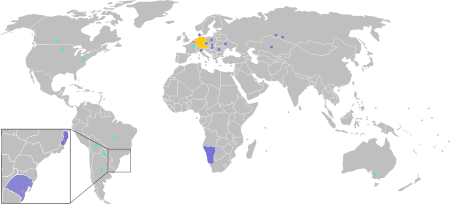
A visible sign of the geographical extension of the German language is the German-language media outside the German-speaking countries. German is the second most commonly used scientific language[120] as well as the third most widely used language on websites after English and Russian.[121]
Deutsche Welle (German pronunciation: [ˈdɔʏtʃə ˈvɛlə]; "German Wave" in German), or DW, is Germany's public international broadcaster. The service is available in 30 languages. DW's satellite television service consists of channels in German, English, Spanish, and Arabic.
German-speaking people living abroad (and people wanting to learn German) can visit the websites of German-language newspapers and TV- and radio stations. The free software MediathekView allows the downloading of videos from the websites of some public German, Austrian, and Swiss TV stations and of the public Franco-German TV network ARTE. With the webpage "onlinetvrecorder.com," it is possible to record programs of many German and some international TV stations.
Note that some material is region-restricted due to legal reasons and cannot be accessed from everywhere in the world. Some websites have a paywall or limit the access for free/unregistered users.
See also:
- List of newspapers in Germany and List of German-language newspapers published in the United States
- List of magazines in Germany
- List of television stations in Germany and List of German-language television channels
- List of radio stations in Germany and List of German-language radio stations
- Goethe-Institut [ˈɡøːtə ʔɪnstiˌtuːt] (a non-profit German cultural association operational worldwide with 159 institutes, promoting the study of the German language abroad and encouraging international cultural exchange and relations.)
Germany's policy on dual citizenship
German nationality law allows dual citizenship with other EU countries and Switzerland; with other countries, it is possible in some cases:
- With special permission ("Beibehaltungsgenehmigung"), for which German citizens must apply before taking the other citizenship (otherwise, German citizenship is automatically lost). Non-EU and non-Swiss citizens wanting to be naturalized in Germany must usually renounce their old citizenship, but may keep it if their country does not allow the renunciation of citizenship, or if the renunciation process is too difficult/humiliating/expensive, or, rarely, in individual cases if the renunciation of the old citizenship means enormous disadvantages for the concerned person.
- If dual citizenship was obtained at birth. Some countries do not accept the "dual-citizenship-by-birth principle," so the concerned person must later choose one citizenship and renounce the other.
- Under Article 116 par. 2 of the Basic Law (Grundgesetz), former German citizens who between January 30, 1933, and May 8, 1945, were deprived of their German citizenship on political, racial, or religious grounds may re-invoke their citizenship and the same applies to their descendants, and are permitted to hold dual (or multiple) citizenship.[122]
A law adopted in June 2019 allows the revocation of the German citizenship of dual citizens who have joined or supported a terror militia such as the Islamic State and are at least 18 years old.
Naturalized Germans can lose their German citizenship if it is found out that they got it by willful deceit / bribery / menacing / giving intentionally false or incomplete information that had been important for the naturalization process. In June 2019, it was decided to prolong the deadline from 5 to 10 years after naturalization.
Visa requirements

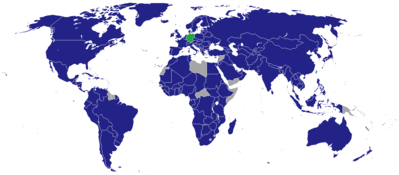
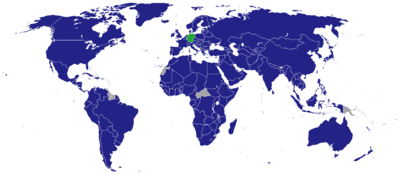
As of 7 January 2020, German citizens can visit 189 countries without a visa or with visa on arrival. The Henley Passport Index ranks the German passport third in the world in terms of travel freedom.
Freedom of movement within other EU countries and the EFTA countries
As EU citizens, Germans can live and work indefinitely in other EU countries and the EFTA countries; however, the right to vote and work in certain sensitive fields (such as government, police, military) might in some cases be restricted to the local citizens only. The EU/EFTA countries can exclude immigrants from getting welfare for a certain time period to avoid "welfare tourism," and they can refuse welfare completely if the immigrants do not have a job after a certain period of time and do not try to get one. Immigrants convicted of welfare fraud can be deported and be refused the re-entry of the country.
Right to consular protection in non-EU countries
When in a non-EU country where there is no German embassy, Germans as EU citizens have the right to get consular protection from the embassy of any other EU country present in that country. See List of diplomatic missions of Germany and List of diplomatic missions in Germany.
German citizens can be extradited only to other EU countries or to international courts of justice, and only if a law allows this (German Basic Law, Art. 16). Before the introduction of the European Arrest Warrant, the extradition of German citizens was generally prohibited by the German Basic Law.
Germany regularly publishes travel warnings on the website of the Auswärtiges Amt (Federal Foreign Office) to its citizens. The Office allows German citizens to register online in a special list, the Krisenvorsorgeliste ("Crisis-Prevention List") before they travel abroad (Elektronische Erfassung von Deutschen im Ausland [ELEFAND] Electronic Registration of Germans Being Abroad). With a password, the registered persons can change or update their data. The registration is voluntary and free of charge. It can be used for longer stays (longer than 6 months), but also for a vacation of only two weeks. The earliest date of registration is 10 days before the planned trip.
Worldwide travel warning in 2020 due to the coronavirus pandemic
On April 17, 2020, the German Auswärtiges Amt (Federal Foreign Office) published a worldwide travel warning on its website and advised German citizens not to take unnecessary trips abroad.
Meanwhile (July 2020), the warning has been revoked for other EU countries, the EFTA countries, and the microstates (Andorra, Monaco, San Marino, and Vatican City).
The German Government advises its citizens against traveling to Ireland, Malta, and the United Kingdom because of their strict quarantine prescriptions.
On its website, the Auswärtiges Amt will regularly update travel information.
Footnotes
- This is an American Community Survey estimate, not a United States Census number.
- Afrikaners are predominantly of Dutch, but also of German and English ancestries.
- This number represents native Alsatian speakers.
- This number counts only Germans in South Tyrol.
- This figure includes children born to British Military personnel serving on British Military bases in Germany
- Depends on definition; see Swiss people.
- Depends on definition; see Austrians.
- Approximately 73,000 people constitute the German-speaking Community of Belgium.
- Depends on definition; see Liechtensteiners.
- Depends on definition; see Luxembourgers.
See also
- Geographical distribution of German speakers
- German dialects
- German language in Europe
- German question
- Germanic peoples
- Imperial Germans
- Pan-Germanism
- Unification of Germany
- Völkisch movement
Notes
Most numbers are from the www.ethnologue.com, apart from a few from German language and Germans, as well as the following:
- "Regular Session 2009-2010 Senate Resolution 141 P.N. 1216". Retrieved 5 March 2015.
- "CACW – Centro Argentino Cultural "WOLGADEUTSCHE"". Archived from the original on 7 February 2009. Retrieved 5 March 2015.
- Levy, Maria Stella Ferreira (1974). "O Papel Da Migração Internacional Na Evolução Da População Brasileira (1872 a 1972)" (PDF). p. 57.
- "Reflecting a Nation: Stories from the 2011 Census, 2012–2013". 2011 Census. Australian Bureau of Statistics. Retrieved 19 March 2013.
- "Alemanes en Chile: entre el pasado colono y el presente empresarial | Sociedad |" (PDF). DW.DE. 31 March 2011. Archived from the original (PDF) on 2 November 2012. Retrieved 7 January 2013.
- "Number of Germans in Silesia (difficulties with the latest census)" (in Polish). Lubczasopismo.salon24.pl. Retrieved 7 January 2013.
- Bureau, U.S. Census. "American FactFinder - Results". factfinder2.census.gov. Archived from the original on 28 January 2015.
- "Demografia – Imigrações: A imigração alemã" [Demographics – Immigration: German immigration]. Deustche Welle (in Portuguese). passeiweb.com. Retrieved 12 February 2016.
Germans represent approximately 5% of immigrants seeking a new homeland in Brazil. Over a period of more than a hundred years, approximately 250,000 Germans have arrived in Brazil. Currently, it is estimated German descendants number at five million on Brazilian soil.
- Including Volga Germans, German Swiss, Mennonites, and other German ancestries"Centro Argentino Cultural Wolgadeutsche". Archived from the original on 6 October 2011. Retrieved 2011-05-31.
- "Internet Archive Wayback Machine". 13 February 2010. Archived from the original on 13 February 2010. Retrieved 2 August 2012.
- "Obsevatorio de Colectividades – Comunidad Alemana". Buenosaires.gob.ar. Archived from the original on 28 November 2011. Retrieved 28 September 2011.
- 2011 Canadian Census gives 2,594,805 total respondents stating their ethnic origin as partly German, with 608,520 stating "single-ancestry", see List of Canadians by ethnicity.
- "Germans in South Africa". Webcitation.org. Archived from the original on 9 October 2009. Retrieved 28 September 2011.
- Professor JA Heese in his book Die Herkoms van die Afrikaner (The Origins of Afrikaners) claims the modern Afrikaners (who total around 3.5 million) have 34.4% German heritage. How 'Pure' was the Average Afrikaner? Archived 13 October 2012 at the Wayback Machine
- Vladimir Geroimenko. "France". Ling.gu.se. Retrieved 28 September 2011.
- "Alsatians". Everyculture.com. 16 January 2010. Retrieved 28 September 2011.
- https://www.deutsche-im-ausland.org/im-ausland-leben-und-arbeiten/leben-im-ausland/daten-und-fakten.html
- étrangères, Ministère de l'Europe et des Affaires. "Présentation de l'Allemagne". France Diplomatie : : Ministère de l'Europe et des Affaires étrangères.
- "Résultats de la recherche - Insee". www.insee.fr.
- German is spoken by ca. 135,000 , about 105,000 of them Germany-born, see Demographics of Australia
- "Alemanes en Chile: entre el pasado colono y el presente empresarial - DW - 31.03.2011". DW.COM.
- "Bolivia". WorldStatesMen. Retrieved 16 June 2013.
white 10% (of which German 3%) (2001)
- Garssen, Joop, Han Nicolaas and Arno Sprangers (2005). "Demografie van de allochtonen in Nederland" (PDF) (in Dutch). Centraal Bureau voor de Statistiek. Retrieved 2 July 2011.CS1 maint: multiple names: authors list (link)
- "CBS StatLine - Population; sex, age, migration background and generation, 1 January". statline.cbs.nl.
- "astat info Nr. 38" (PDF). Table 1 — Declarations of which language group belong to/affiliated to — Population Census 2011. Archived from the original (PDF) on 12 August 2011.
- German born only; Britain's German-born population prefers life under the radar
- 2008, 0.15% of UK population. statistics.gov.uk Archived 28 June 2011 at the Wayback Machine
- "Paraguay". WorldStatesMen. Retrieved 16 June 2013.
Ethnic groups: mestizo (mixed white and Amerindian) 85.6%, white 9.3% (of which German 4.4%, Latin American 3.4%), Amerindian 1.8%, black 1%, other 2.3% (2000)
- 265,944 (2009, 3.3% of Swiss population) Wohnbevölkerung nach detaillierter Staatsangehörigkeit Archived 16 October 2012 at the Wayback Machine, Swiss Federal Statistical Office. 163 923 resident aliens (nationals or citizens) in 2004 (2.2% of total population), compared to 112 348 as of 2000. 2005 report of the Swiss Federal Office of Statistics Archived 23 September 2015 at the Wayback Machine. 4.6 million including Alemannic Swiss: CIA World Fact Book, identifies the 65% (4.9 million) Swiss German speakers as "ethnic Germans".
- (in German) Deutsche Einwanderung in Peru Archived 15 October 2017 at the Wayback Machine
- Перепись населения Казахстана (2009)
- Govan, Fiona (22 April 2014). "End to Mediterranean dream for 90,000 Britons who left Spain last year" – via www.telegraph.co.uk.
- Przynależność narodowo-etniczna ludności – wyniki spisu ludności i mieszkań 2011. GUS. Materiał na konferencję prasową w dniu 29. 01. 2013. p. 3. Retrieved 2013-03-06.
- Hungarian census 2011 - final data and methodology
- AUSTRIA, STATISTIK. "Bevölkerung nach Staatsangehörigkeit und Geburtsland". www.statistik.at.
- "Money overcomes ideology as Israelis hunt down German passports| Yediot Ahronot | 31.05.2011". Ynetnews. 20 June 1995. Retrieved 28 September 2011.
- "2011 census" (PDF).
- Amt, Auswärtiges. "Federal Foreign Office - Federal Foreign Office". Auswärtiges Amt DE.
- "There are 6,000 Germans living in Uruguay today and 40,000 descendants of Germans" (in German). Auswaertiges-amt.de. Retrieved 28 September 2011.
- "Ethnic German Minorities in the Czech Republic, Poland and Slovakia". Radio.cz. Retrieved 28 September 2011.
- Personer med innvandringsbakgrunn, etter innvandringskategori, landbakgrunn og kjønn. 1. januar 2012 Archived 18 September 2012 at the Wayback Machine Statistics Norway, retrieved 11 January 2013
- "Namibia Restores An African Name To Historic Caprivi Strip".
- "Dominican Republic" (in German). Auswaertiges-amt.de. Retrieved 28 September 2011.
- Martínez, Darlenny (2 May 2013). "Estudio: en RD viven 534,632 extranjeros". El Caribe (in Spanish). Retrieved 29 May 2014.
Según la Primera Encuesta Nacional de Inmigrantes de la República Dominicana (ENI-2012), (...) Después de Haití, explica la investigación, las 10 naciones de donde proceden más inmigrantes son Estados Unidos, con 13,524; España, con 6,720, y Puerto Rico, con 4,416. Además Italia, con 4,040; China, con 3,643; Francia, con 3,599; Venezuela, con 3,434; Cuba con 3,145 inmigrantes; Colombia con 2,738 y Alemania con 1,792.
- Bund Deutscher Nordschleswiger Archived 16 March 2013 at the Wayback Machine
- "Archived copy". Archived from the original on 26 March 2013. Retrieved 2014-05-27.CS1 maint: archived copy as title (link)
- "Greeks Census 2001" (PDF). Archived from the original (PDF) on 14 November 2010. Retrieved 28 September 2011.
- CSO Ireland - Persons usually resident and present in the State on Census Night (2006), classified by place of birth and age group Archived 12 August 2011 at the Wayback Machine
- "CSO Emigration" (PDF). Census Office Ireland. Retrieved 29 January 2013.
- 2010 Population and Housing Census Housing Characteristics Archived 11 June 2012 at the Wayback Machine
- "Slovakia" (in German). Auswaertiges-amt.de. Retrieved 28 September 2011.
- 2000 census
- "Migration profile 2016" (PDF). Archived from the original (PDF) on 8 July 2018. Retrieved 8 July 2018.
- "Central Bureau of Statistics". www.dzs.hr.
- https://www.un.org/en/development/desa/population/migration/data/estimates2/estimates19.asp
- http://pxnet2.stat.fi/PXWeb/pxweb/fi/StatFin/StatFin__vrm__vaerak/statfin_vaerak_pxt_11rh.px/
- "População Estrangeira Residente em Portugal - Alemanha" (PDF). Ministério da Economia. 20 June 2018. Retrieved 19 May 2019.
- https://www.scb.se/hitta-statistik/statistik-efter-amne/befolkning/befolkningens-sammansattning/befolkningsstatistik/pong/tabell-och-diagram/helarsstatistik--riket/befolkning-efter-fodelseland-och-ursprungsland/
- http://www.statistikdatabasen.scb.se/pxweb/sv/ssd/START__BE__BE0101__BE0101N/MedborgarByteTotK/?rxid=3ca01d5d-1462-4a10-af7c-a22369234ee9
- "Spend Relaxingly". www.cobanav.net.
- "Deutsche Botschaft Guatemala - Startseite". Archived from the original on 14 January 2016. Retrieved 7 January 2016.
- http://www.dw.com/es/alemanes-en-colombia-en-búsqueda-de-oportunidades/a-14995959
- "Wayback Machine". 18 July 2010. Archived from the original on 18 July 2010.
- derStandard.at. "Österreicher fühlen sich heute als Nation - 1938 - derStandard.at " Wissenschaft". Derstandard.at. Retrieved 25 August 2012.
- H. Lohninger (6 December 2010). "Austrian National Identity". Photoglobe.info. Retrieved 25 August 2012.
- Sutherland, Claire; Barabantseva, Elena (2013). Diaspora and Citizenship. Oxon: Routledge. p. 97. ISBN 9780415594127.
- cf. the article on the Luxemburgish language on the German Wikipedia
- "Liberation – Post War Changes". Livingprague.com. Retrieved 25 August 2012.
- "Ethnic German Minorities in the Czech Republic, Poland and Slovakia". Radio.cz. Retrieved 25 August 2012.
- "Universitat Oberta de Catalunya". Uoc.es. Retrieved 25 August 2012.
- ""History of German Settlements in Southern Hungary" by Sue Clarkson". Feefhs.org. Archived from the original on 4 February 1997. Retrieved 25 August 2012.
- "Südtirol: Neue Initiative für Doppel-Staatsbürgerschaft «". Diepresse.com. Retrieved 25 August 2012.
- https://books.google.com/books?id=PVtE1FnphtYC&pg=PA200&lpg=PA200&dq=immigrazione+minatori+tedeschi+sardegna&source=bl&ots=2XP7M6ttNu&sig=wcG9IaBJA_p0MUl3VmP89LVQdT0&hl=it&sa=X&ved=0CD8Q6AEwBWoVChMIgZ3o44C5xwIVhFYaCh18IwId#v=onepage&q=tedeschi&f=false guida d'italia touring club italiano 2002
- ^ Stefano Musso, op. cit., p.314
- atzori, martino. "www.sardegnaminiere.it". www.sardegnaminiere.it. Archived from the original on 4 April 2015. Retrieved 21 August 2015.
- https://www.kommuneprofilen.no/Profil/Befolkning/DinRegion/bef_innvandrere_land_region.aspx. Missing or empty
|title=(help) - {{Cite web|url=https://www.arkivverket.no/utforsk-arkivene/eldre-historie--1814/innvandring-til-norge-er-ikke-noe-nytt.folk-har-kommet-hit-i-1000-%C3%A5r-%E2%80%93-og-mer-enn-det}%5B%5D
- {{Cite web|url=https://www.kommuneprofilen.no/Profil/Befolkning/Bench/bef_innvandrere_land_bench.aspx}%5B%5D
- {{Cite web|url=https://forskning.no/senter-for-internasjonalisering-av-utdanning-skole-og-utdanning-partner/derfor-velger-europeiske-studenter-norge/351205}
- "Results of the National Census of 2011, GUS, p. 18" (PDF) (in Polish). Stat.gov.pl. Archived from the original (PDF) on 16 June 2012. Retrieved 25 August 2012.
- "How 'Pure' was the Average Afrikaner?". Africanhistory.about.com. 13 April 2012. Archived from the original on 13 October 2012. Retrieved 25 August 2012.
- Deutsche Wanderung nach Südafrika im 19. Jahrhundert by Werner Schmidt-Pretoria.
- German L1 speakers outside Europe
- Cascante, Manuel M. (8 August 2012). "Los menonitas dejan México". ABC (in Spanish). Retrieved 19 February 2013.
Los cien mil miembros de esta comunidad anabaptista, establecida en Chihuahua desde 1922, se plantean emigrar a la república rusa de Tartaristán, que se ofrece a acogerlos
- International Encyclopedia of Linguistics: 4-Volume Set, Volumen 1 Page 94
- Horst Kopp Area Studies, Business and Culture: Results of the Bavarian Research Network Forarea (2003)
- From Census Bureau, "S0201. Selected Population Profile in the United State" 2006-2008 data Archived 10 February 2020 at Archive.today
- Who's Counting? The 1990 Census of German-Americans Archived 9 October 2004 at the Wayback Machine. On the site of The Tricentennial Foundation German American Community Service. Accessed 12 February 2006.
- Contents of ANCESTRY Table on the site of the United States Census Bureau. Accessed 12 February 2006.
- Thomas Schoonover (2008). Hitler's Man in Havana: Heinz Luning and Nazi Espionage in Latin America. United States of America: The University Press of Kentucky. p. 35. ISBN 978-0-8131-2501-5. Retrieved 27 May 2014.
- "Fiesta de La Cerveza – Oktoberfest Argentina – Vill". Elsitiodelavilla.com. Archived from the original on 2 July 2015. Retrieved 25 August 2012.
- "FUNCIONES DEL DEPARTAMENTO CULTURAL". 13 February 2010. Archived from the original on 13 February 2010. Retrieved 25 August 2012.
- "Obsevatorio de Colectividades – Comunidad Alemana". Buenosaires.gob.ar. Archived from the original on 28 November 2011. Retrieved 28 September 2011.
- NATHANIEL C. NASH (14 December 1993). "Argentine Files Show Huge Effort to Harbor Nazis". Nytimes.com. Retrieved 25 August 2012.
- Handwörterbuch des politischen Systems der Bundesrepublik (in German). Source lists "German expatriate citizens" only for Namibia and South Africa!
- "Composición Étnica de las Tres Áreas Culturales del Continente Americano al Comienzo del Siglo XXI" (PDF) (in Spanish). p. 188. Archived from the original (PDF) on 26 June 2013. Retrieved 12 June 2012.
- Bolivian Reforms Raise Anxiety on Mennonite Frontier, New York Times(subscription required)
- Los Menonitas en Bolivia Archived 3 December 2013 at the Wayback Machine CNN en Español
- "A Imigração Alemã no Brasil" (in Portuguese). Deustche Welle. 25 July 2004. Retrieved 7 October 2012.
- Gippert, Jost. "TITUS Didactica: German Dialects (map)". titus.uni-frankfurt.de.
- "Pommern in Brasilien - LernCafe – Online-Journal zur allgemeinen Weiterbildung". www.lerncafe.de.
- Luna Bolivar Manaut (31 March 2011). "Alemanes en Chile: entre el pasado colono y el presente empresarial" (in Spanish). Deustche-Welle. Retrieved 11 November 2012.
- Handwörterbuch des politischen Systems der Bundesrepublik Archived 5 April 2013 at the Wayback Machine (in German).
- "The Mennonite Old Colony Vision: Under siege in Mexico and the Canadian Connection" (PDF). Archived from the original (PDF) on 16 July 2004. Retrieved 30 May 2007.
- Rosenberg, Peter. "Deutsche Minderheiten in Lateinamerika" (PDF). Archived from the original (PDF) on 2 November 2012. Retrieved 11 November 2012.
- Erwin Dopf. "Peruano-alemán". Espejodelperu.com.pe. Retrieved 25 August 2012.
- "POZUZO. Historia – caractersiticas generales – Antecedentes Caminos y vias :: antecedentes historicos clima flora y fauna posuso pozuso posuzo". Riie.com.pe. Retrieved 25 August 2012.
- title-->
- "Deutsche-in-Peru / Inmigración Alemana al Perú". Archived from the original on 23 November 2009.
- Eberhardt, Piotr (2006). Political Migrations in Poland 1939-1948. 8. Evacuation and flight of the German population to the Potsdam Germany (PDF). Warsaw: Didactica. ISBN 9781536110357. Archived from the original (PDF) on 26 June 2015.
- Eberhardt, Piotr (2011). Political Migrations On Polish Territories (1939-1950) (PDF). Warsaw: Polish Academy of Sciences. ISBN 978-83-61590-46-0.
- "Ethnologue report for Poland". Ethnologue.com. Archived from the original on 6 October 2001. Retrieved 25 August 2012.
- "Ministerstwo Spraw Wewnętrznych". Mswia.gov.pl. Retrieved 25 August 2012.
- German Population of Romania, 1930-1948 Archived 17 August 2007 at the Wayback Machine
- "German minority" (in German). Auswaertiges-amt.de. Retrieved 25 August 2012.
- "EUROPA – Education and Training – Regional and minority languages – Euromosaïc study". Archived from the original on 19 September 2006. Retrieved 5 March 2015.
- "German and Jewish migration from the former Soviet Union to Germany". Ingentaconnect.com. 1 October 2000. Retrieved 25 August 2012.
- "UNDP Human Development Report for Serbia 2005" (PDF). Retrieved 25 August 2012.
- "Why Learn German?". Goethe Institute. Retrieved 28 September 2014.
- "Usage of content languages for websites". W3Techs: Web Technology Surveys. Retrieved 18 February 2019.
- German Mission to the United States. "Information on the Naturalization Claim under Article 116 (2) of the German Basic Law" (PDF). www.germany.info. Government of Germany. Archived from the original (PDF) on 19 October 2018. Retrieved 18 October 2018.